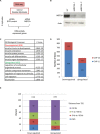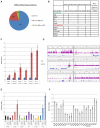Global MEF2 target gene analysis in cardiac and skeletal muscle reveals novel regulation of DUSP6 by p38MAPK-MEF2 signaling
- PMID: 25217591
- PMCID: PMC4191398
- DOI: 10.1093/nar/gku813
Global MEF2 target gene analysis in cardiac and skeletal muscle reveals novel regulation of DUSP6 by p38MAPK-MEF2 signaling
Abstract
MEF2 plays a profound role in the regulation of transcription in cardiac and skeletal muscle lineages. To define the overlapping and unique MEF2A genomic targets, we utilized ChIP-exo analysis of cardiomyocytes and skeletal myoblasts. Of the 2783 and 1648 MEF2A binding peaks in skeletal myoblasts and cardiomyocytes, respectively, 294 common binding sites were identified. Genomic targets were compared to differentially expressed genes in RNA-seq analysis of MEF2A depleted myogenic cells, revealing two prominent genetic networks. Genes largely associated with muscle development were down-regulated by loss of MEF2A while up-regulated genes reveal a previously unrecognized function of MEF2A in suppressing growth/proliferative genes. Several up-regulated (Tprg, Mctp2, Kitl, Prrx1, Dusp6) and down-regulated (Atp1a2, Hspb7, Tmem182, Sorbs2, Lmod3) MEF2A target genes were chosen for further investigation. Interestingly, siRNA targeting of the MEF2A/D heterodimer revealed a somewhat divergent role in the regulation of Dusp6, a MAPK phosphatase, in cardiac and skeletal myogenic lineages. Furthermore, MEF2D functions as a p38MAPK-dependent repressor of Dusp6 in myoblasts. These data illustrate that MEF2 orchestrates both common and non-overlapping programs of signal-dependent gene expression in skeletal and cardiac muscle lineages.
© The Author(s) 2014. Published by Oxford University Press on behalf of Nucleic Acids Research.
Figures





Similar articles
-
Cross-talk between glycogen synthase kinase 3β (GSK3β) and p38MAPK regulates myocyte enhancer factor 2 (MEF2) activity in skeletal and cardiac muscle.J Mol Cell Cardiol. 2013 Jan;54:35-44. doi: 10.1016/j.yjmcc.2012.10.013. Epub 2012 Nov 5. J Mol Cell Cardiol. 2013. PMID: 23137781
-
Regulation of Hspb7 by MEF2 and AP-1: implications for Hspb7 in muscle atrophy.J Cell Sci. 2016 Nov 1;129(21):4076-4090. doi: 10.1242/jcs.190009. Epub 2016 Sep 15. J Cell Sci. 2016. PMID: 27632998
-
MEF2A regulates Calpain 3 expression in L6 myoblasts.Gene. 2018 Aug 20;668:204-210. doi: 10.1016/j.gene.2018.05.056. Epub 2018 May 18. Gene. 2018. PMID: 29783071
-
Regulating a master regulator: establishing tissue-specific gene expression in skeletal muscle.Epigenetics. 2010 Nov-Dec;5(8):691-5. doi: 10.4161/epi.5.8.13045. Epub 2010 Nov 1. Epigenetics. 2010. PMID: 20716948 Free PMC article. Review.
-
Skeletal muscle mass is controlled by the MRF4-MEF2 axis.Curr Opin Clin Nutr Metab Care. 2018 May;21(3):164-167. doi: 10.1097/MCO.0000000000000456. Curr Opin Clin Nutr Metab Care. 2018. PMID: 29389722 Review.
Cited by
-
MEF2 impairment underlies skeletal muscle atrophy in polyglutamine disease.Acta Neuropathol. 2020 Jul;140(1):63-80. doi: 10.1007/s00401-020-02156-4. Epub 2020 Apr 18. Acta Neuropathol. 2020. PMID: 32306066 Free PMC article.
-
Muscle-relevant genes marked by stable H3K4me2/3 profiles and enriched MyoD binding during myogenic differentiation.PLoS One. 2017 Jun 13;12(6):e0179464. doi: 10.1371/journal.pone.0179464. eCollection 2017. PLoS One. 2017. PMID: 28609469 Free PMC article.
-
Heart Failure and MEF2 Transcriptome Dynamics in Response to β-Blockers.Sci Rep. 2017 Jun 30;7(1):4476. doi: 10.1038/s41598-017-04762-x. Sci Rep. 2017. PMID: 28667250 Free PMC article.
-
Q-nexus: a comprehensive and efficient analysis pipeline designed for ChIP-nexus.BMC Genomics. 2016 Nov 4;17(1):873. doi: 10.1186/s12864-016-3164-6. BMC Genomics. 2016. PMID: 27814676 Free PMC article.
-
Remodeling of gene regulatory networks underlying thermogenic stimuli-induced adipose beiging.Commun Biol. 2022 Jun 14;5(1):584. doi: 10.1038/s42003-022-03531-5. Commun Biol. 2022. PMID: 35701601 Free PMC article.
References
-
- Lin Q., Lu J., Yanagisawa H., Webb R., Lyons G.E., Richardson J.A., Olson E.N. Requirement of the MADS-box transcription factor MEF2C for vascular development. Development. 1998;125:4565–4574. - PubMed
-
- Edmondson D.G., Lyons G.E., Martin J.F., Olson E.N. Mef2 gene-expression marks the cardiac and skeletal-muscle lineages during mouse embryogenesis. Development. 1994;120:1251–1263. - PubMed
-
- Pollock R., Treisman R. Human srf-related proteins—dna-binding properties and potential regulatory targets. Genes Dev. 1991;5:2327–2341. - PubMed
Publication types
MeSH terms
Substances
Associated data
- Actions
Grants and funding
LinkOut - more resources
Full Text Sources
Other Literature Sources
Molecular Biology Databases
Miscellaneous

